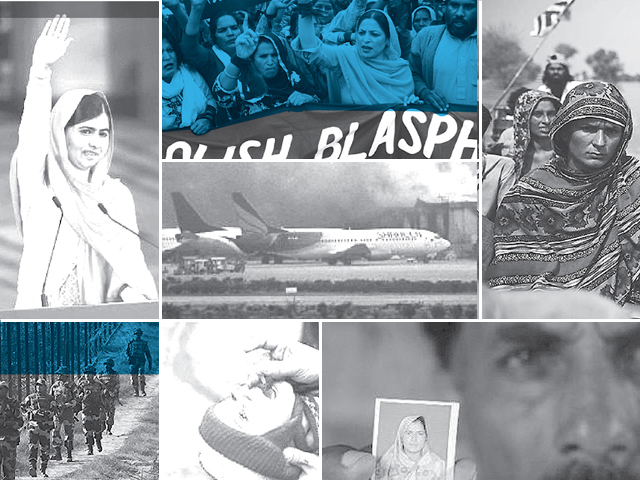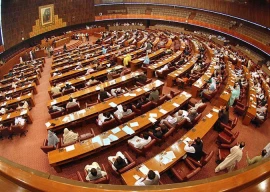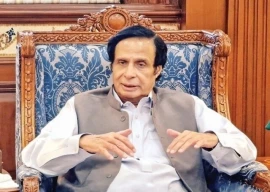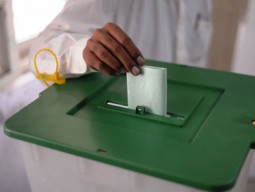
In 2014, Pakistan bore some of the heaviest blows from terrorism. The country reeled from shock after shock and suffered from the chronic politicisation of the judiciary and its lawmakers’ negligence. No time was spared on formulating a solid foreign policy. In the wake of compounding regional challenges, the county did not have any better luck with domestic issues either as health, education and security remained in continuous jeopardy.
We did, however, make some historic achievements. In October this year, Malala Yousafzai became the youngest recipient of the Nobel Peace Prize. The women’s cricket team brought home the gold at the Asian games. And by the end of 2014, politicians, the military, judiciary and the civil society coalesced their energies and united against terrorism with fresh vigour and determination. We enter 2015 with a heavy heart, but renewed hope.
1. Pak-India relations

A view of the fenced border between India and Pakistan. PHOTO: REUTERS
Erratic gestures of warmth between India and Pakistan in 2014 did little to thaw the stiffness that persists between the two countries. India emerged if not the more aggressive, then certainly the more irritable of the two as Pakistan hastened to dispatch mangoes to Mr Modi and saris to his mother, ultimately without reward.
Alas, replenishments to Mommy Modi’s closet and the Indian state pride did little to encourage India to shake hands willingly with Nawaz Sharif during the SAARC summit or to hold foreign-secretary level talks in a huff. Fishermen, truck drivers, hockey players and university students have all borne the brunt of the impasse in state-level relations during 2014 as both continued to point fingers over water and border violations, cross-border aggression and similar points of ‘whodunnit’. In 2014, a solution to the Kashmir conundrum remained elusive as ever.

The markers of confidence building were so scattered, and the whole process tied with preliminary consensus on so many issues, that it was difficult to untangle it all through a flurry of delegation exchanges. No amount of Pakistani dramas on Indian television or phone calls of commiseration from India in the wake of the Peshawar school tragedy could break the ice. The final blow of 2014 came with the bail for Zakiur Rehman Lakhvi — the alleged mastermind behind the 2008 Mumbai attack — a move which undid any make-believe friendship that may have been conjured by the internationally-coaxed handshake between Nawaz and Modi at the SAARC summit.
2. Polio

A health worker gives a child the polio vaccine in Bannu. PHOTO: AFP
The world watched in alarm as Pakistan continued to offset the downward trend of global polio incidence, with cases surfacing from all four provinces in 2014. Despite international outrage, widespread condemnations and frenzied vaccination campaigns, polio cases stood at a 15-year high with a 260-plus tally. In late April, the World Health Organization thundered down with suggestions of travel restrictions for Pakistanis and went as far as to announce a health emergency in the country which stirred the federal health office into renewed action.

Earlier in October, Pakistan broke its own 14-year-old record when it crossed 200 polio cases. PHOTO: REUTERS
On the ground, the health ministry instructed immigration offices to ensure that travellers were vaccinated, while travellers remained uncertain about the logistics of procuring a ‘polio pass’ in the absence of any ministry notices. Eventually, key hospitals and airports all over the country began administering the polio vaccine to adults and issuing certificates. Despite it all, the epidemic spread as the unvaccinated population of displaced persons from the war-ravaged and largely-inaccessible North Waziristan poured into cities all over the country. Meanwhile health workers giving polio drops to children continued to be targeted by militants — over 65 are said to have come under attack since 2012 — making it one of the most dangerous jobs in the country.

The total collapse of Pakistan’s polio prevention system remained one of the biggest health failures of the decade, specially considering that polio is overseen by special offices under each of the chief ministers, the Prime Minister’s Monitoring & Coordination Cell for Polio and the myriad international and non-governmental organisations.
3. Operation Zarb-e-Azb

The Karachi airport was attacked by the Taliban. PHOTO: REUTERS
As peace talks with the Tehreek-e-Taliban Pakistan (TTP) scuttled, the Pakistan armed forces stormed through the North Waziristan valley on the evening of June 15, kick-starting Operation Zarb-e-Azb. A combination of ground troops, artillery, tanks and aerial blitzes was used to indiscriminately target the Uzbek, Chinese, Pakistani, Arab and Afghan militant strongholds in the valley, putting an end to the strategic confusion that plagued the national conversation on terrorism for months. From January till the launch of the operation, the country was on tenterhooks, watching the civilian government nervously as it dispatched delegation after delegation for peace talks with militants who demanded nothing less than the state’s submission. Efforts by the government to abate the bloodshed through peace talks continued even after the TTP slaughtered 23 Frontier Corps personnel in Mohmand Agency, despite strong voices urging the government to declare total war. The conversation, however, reached a breaking point after the Karachi airport attack on June 8, a week after which the operation was set in motion.

Responses to Operation Zarb-e-Azb have remained controversial with politicians and civil society members repeatedly urging caution against non-militants in the valley. Meanwhile, the displaced population of North Waziristan has poured into Khyber-Pakhtunkhwa (K-P) making for a challenge that the war strategy had overlooked. As the province cracks beneath the burden of rehabilitating, securing and providing health services to distressed, displaced tribal people, they wait for the conclusion of a war that seemingly has no end.
4. Children — a new target

Students rescued from an attack on the Army Public School. PHOTO: REUTERS
While child casualties have been the norm in a number of attacks in Pakistan since 2004, the specific targeting and direct involvement of young ones in such incidents cropped up in the news at an alarming frequency throughout the year. Two girls’ schools in Bajaur Agency and Bara were attacked in September and October. No casualties, however, were reported. On January 9, 2014, a suicide attack on a Hangu school was prevented by the 15-year-old student Aitzaz Hasan, who lost his life while keeping the terrorist at bay from his school. The brave young man emerged as a national hero, with generous tributes paid to him from all corners of the country.

Schoolchildren in some parts of Balochistan spent a jittery year too. Starting May, terrorist groups circulated inflammatory literature against Western models of education, threatening to target schools in Panjgur and Turbat. On May 7, students and teachers were terrorised at an English language centre in Panjgur while on May 13, militants torched a school van. In the wake of threat and fear of students’ lives, schools across the district were closed one by one. By the last week of May, all were closed, and schoolchildren, fearful about their lives and studies, went on an indefinite holiday. It was in the first week of August that school activities resumed amid an atmosphere of fear.
The Army Public School attack in Peshawar was a horror of unprecedented proportions for the country. It must, however, be understood differently from other school attacks since it was not targeted for differences over school curriculum. It was, on the other hand, an onslaught on children by TTP militants, who targeted them in order to avenge for the war that the military has been fighting in North Waziristan. Pakistan roared in rage and cried out in grief at the loss of 132 young lives. Mercy petitions of TTP terrorists on death row were rescinded and the country began carrying out the first civilian-led executions since the de facto moratorium in 2008. Six convicts tried under military court have already been hanged. As we enter 2015, the state, exhausted and bruised by this incident, seems to have surrendered that language of caution while talking terrorism.
While child casualties have been the norm in a number of attacks in Pakistan since 2004, the specific targeting and direct involvement of young ones in such incidents cropped up in the news at an alarming frequency throughout the year. Two girls’ schools in Bajaur Agency and Bara were attacked in September and October. No casualties, however, were reported. On January 9, 2014, a suicide attack on a Hangu school was prevented by the 15-year-old student Aitzaz Hasan, who lost his life while keeping the terrorist at bay from his school. The brave young man emerged as a national hero, with generous tributes paid to him from all corners of the country.
Schoolchildren in some parts of Balochistan spent a jittery year too. Starting May, terrorist groups circulated inflammatory literature against Western models of education, threatening to target schools in Panjgur and Turbat. On May 7, students and teachers were terrorised at an English language centre in Panjgur while on May 13, militants torched a school van. In the wake of threat and fear of students’ lives, schools across the district were closed one by one. By the last week of May, all were closed, and schoolchildren, fearful about their lives and studies, went on an indefinite holiday. It was in the first week of August that school activities resumed amid an atmosphere of fear.
The Army Public School attack in Peshawar was a horror of unprecedented proportions for the country. It must, however, be understood differently from other school attacks since it was not targeted for differences over school curriculum. It was, on the other hand, an onslaught on children by TTP militants, who targeted them in order to avenge for the war that the military has been fighting in North Waziristan. Pakistan roared in rage and cried out in grief at the loss of 132 young lives. Mercy petitions of TTP terrorists on death row were rescinded and the country began carrying out the first civilian-led executions since the de facto moratorium in 2008. Six convicts tried under military court have already been hanged. As we enter 2015, the state, exhausted and bruised by this incident, seems to have surrendered that language of caution while talking terrorism.
5. Gender-based violence

Pakistani human rights activists hold placards during a protest in Islamabad on May 29, 2014 against the killing of a pregnant woman Farzana Parveen. PHOTO: AFP
The grisliness of Farzana Parveen’s murder in Lahore on May 27 stirred the UN offices, foreign media outlets and the local judiciary alike. The pregnant 25-year-old was pelted with bricks outside the premises of the Lahore High Court and died on the spot. Civil society broke into an uproar and the chief justice took an immediate suo motu notice. The judiciary rolled its sleeves to push the case and bring the perpetrators to the books under the laws of ‘honour’ killing. The legal theatrics of the case finally ended when an anti-terrorism court slapped death sentences on four culprits on November 19.
Strategies of gender-based violence took fresh, creative forms throughout the year. Acid was sprayed from syringes at women publicly in the marketplaces of Quetta, Mastung and Pishin in Balochistan during June and July. The attacks stand out in the history of acid attacks in Pakistan because the women were pedestrians, making their everyday rounds to the market when it happened, and did not recognise the perpetrators.
6
Pakistani resident Mohammad Iqbal holds up an image of his wife Farzana Parveen. PHOTO: AFP
Rape cases were also reported from Layyah, Lahore, Mansehra and Sahiwal.
6. Blasphemy cases

Eleven-year-old Christian girl, Asia Bibi, becomes a victim of intolerance in Pakistan. PHOTO: REUTERS
Those accused and those defending the accused were targeted with similar rage. In May, Rashid Rehman, a lawyer defending a blasphemy-accused lecturer, was shot in his office in Multan after receiving threats against his judicial stance. Hundreds of Muslims and non-Muslims, including convicts in jails, remained terrorised by the threat of extra-judicial killings and mistreatment. In September, a 70-year-old British national, a blasphemy convict, was injured by a policeman in a Rawalpindi jail. The attack roused British offices in Pakistan, with British Prime Minister David Cameron telephoning the prime minister to protest the treatment of the prisoner, urging that he be returned to Britain. Almost a month later, a prison guard in Gujrat murdered a detained man with an axe for making blasphemous remarks.

The nature of blasphemy cases in 2014 set new records. In a first, a popular TV channel was accused of committing blasphemy. In another first, a popular Muslim televangelist, himself a proponent of the blasphemy law, was booked under it for making contentious remarks. Pakistan’s blasphemy paranoia acquired its most hideous form on November 5. On this day, the villagers of Kot Radhakishan in Punjab beat a Christian couple, dragged them through the streets, and eventually tossed them in a blazing kiln to be burnt to death. Helpless policemen looked on as the crowed unleashed its ire against the alleged desecration of the Holy Quran.
7. Dharna activism

Supporters at the azaadi march. PHOTO: REUTERS
Entire neighborhoods from across the country swarmed out on the streets in support of Pakistan Tehreek-e-Insaf leader Imran Khan and Pakistan Awami Tehreek leader Tahirul Qadri. The widespread popularity of dharna politics in 2014 brought about a revival in middle-class activism, which had been dormant for decades. Protestors from either party camped outside key government installations, demanded a re-haul of state institutions and the resignation of the prime minister.
8. Thar drought and floods

Flood victims on a boat, evacuated from their home. PHOTO: REUTERS
The absolute collapse of the disaster management system in Pakistan made international headlines as the floods and Thar famine left hundreds of casualties across Sindh and Punjab. Starting September, the banks of Jhelum and Chenab brimmed menacingly as the northern runoff of water from Kashmir showers drained inside. Jhang, Chiniot, Multan, Jhehlum, Sialkot and Rahimyar Khan, cities and villages alive, were swamped. The flood peak whirled southwards, meandering through the low-lying areas of the Indus plains, and by the last week of September, Khairpur, Naushero Feroz, Kashmore, Muradabad, Thatta, Sial and parts of Muzaffargarh were inundated. In a geography already wearied under the lingering effects of similar floods from 2011, 2012 and 2013, hundreds of families were marooned yet again, their lives and properties washed away.

As parts of Punjab collapsed under too much water, the Tharparkar district of Sindh paid a heavy price for having too little. A months-long dry spell led to a famine-like situation throughout 2014 which resulted in the deaths of hundreds of children and babies from malnutrition while relief organisations and the administration looked on helplessly. Politicians from Sindh even appeared on television and denied the disaster in Thar, unveiling the abject negligence, corruption and mismanagement that imperils the allocation of resources.
9. Malala Yousafzai’s Nobel

Malala Yousafzai (left) holds the Nobel Peace Prize and (right) gives a speech at the awards ceremony . PHOTO: AFP
The conversation on Pakistan’s young education activist, Malala Yousufzai, broached afresh when the 17-year-old won the Nobel Peace Prize with Indian child rights activist Kailash Satyarthi on October 10. Global eulogies for Malala struck a face-off with the chatter at home, where the young schoolgirl’s achievements were often shaped into myriad accusations and defamatory statements. There were widespread reservations in Pakistan on the decision to sideline the country’s favourite philanthropist, Abdus Sattar Edhi, who was favoured over Malala by many for the prize.


Faiza Rahman is a subeditor for the Opinion & Editorial section of The Express Tribune.
Published in The Express Tribune, Sunday Magazine, December 28th, 2014.
COMMENTS (2)
Comments are moderated and generally will be posted if they are on-topic and not abusive.
For more information, please see our Comments FAQ

































































Brilliant stuff ET =)))
What a crap this article is. It will be good if you highlight the good aspects instead of bad. It will be good if you highlight the stunning performance of Pakistan hockey team to reach finals instead of criticize them. No highlights for amazing cricket achievements this year we got beating Australia in tests, fastest century in test cricket history, heroic run chase in test against Srilanka huh. Where is the story of Pakistan born kid becomes world’s youngest Microsoft IT specialist? 5 Pakistani women achieve a place in BBC’s 100 Women List? 7th Largest Mosque in the world is build in 2014 in Pakistan. Saad Haroon on 3rd place in The Funniest Person In The World Competition? World Intelligence agencies ranking Pakistan’s ISI on the top in 2014. Pakistan Tops World With Qur’an Huffaz in 2014 and many many more ............